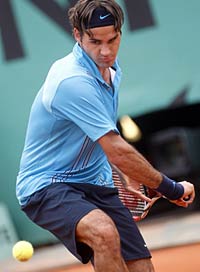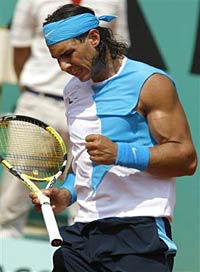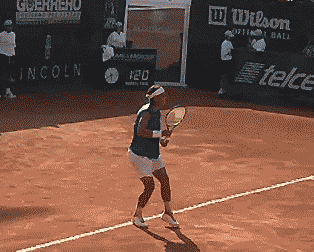|
TennisOne Lessons French Open 2007 – The Indomitable Will to Win Jim McLennan Tennis fans were treated to pretty darn good tennis theater this past weekend. Certainly the French Final did not offer a dramatic fifth set, with fortunes teetering back and forth as balls either clipped or narrowly missed the line. Yet, to have the games two pre-eminent players contesting their second consecutive French Open final gave us all yet another opportunity to pull for Rafa or plead with Roger. They are great players, great friends, they respect one another as well as the traditions of the game, and any of us would be well served to model their comportment, their strokes, or in a merely mortal way to try and move more or less as well as they do.
Federer did not serve well, nor did he play well, and this by his own admission, noting, “How hard it is to play well against Nadal.” But when boiled down to the essentials the game is merely about movement and hitting, and on those scores Nadal is superlative. Rafa doesn’t cover but rather he devours the court, and when it comes to hitting on the move, whether offensive power or defensive accuracy the guy is a cut above all the rest (on clay anyway). Federer has been working on his topspin down the line backhand, in order to attempt to control play while avoiding the punishing Nadal crosscourt high bouncing forehand. But somehow, I believe Nadal was equally working on his own down the line backhand, staying on the line Federer would initiate, but sending it back better. I was amazed at how many backhands Federer threaded down the line, inches from the sideline and baseline, only to see Nadal reply with the identical precision.
But to my eye the match turned on the contest of wills within the break point scenarios in the first set, and again in the fourth set. Federer appears as fit as anyone on the tour, not explosive like a sprinter, but rather lean and strong like a miler. Nadal on the other hand is quick and strong, but to my eye willpower sets Nadal above all the rest. The guy refuses to lose, and he imposes that feeling across the net against any competitor. The guy has never lost a match in three years at Roland Garros! Break points tell the story of the match, both in their number, but equally as much in their cumulative impact when won and lost. Federer again, “Rafael is tough on break points. It’s one thing to create chances but you have to convert them. I came back in the second set but had a bad start in the third set which killed it for me.” And as much as anything, that concluding phrase said it all, Nadal’s willpower on break points “killed the match” for Federer.
Of the 10 break points against Nadal in the first set, Nadal hit but one ace, and no winners. Of the nine remaining break points, Federer made four backhand errors and five forehand errors. The longest was a 12 shot rally ending in a forced backhand error, the shortest two points were forehand return of serve errors. Simply stated, Nadal never made an error when facing game point against his serve. Then to further highlight the contest of wills Nadal broke Federer at love after fighting off these 10 break points when serving at 1-2 and at 2-3. Hopefully we have all been in this position. Squandering (might be a little too harsh but lets go with it) multiple break points it can be next to impossible to put those missed opportunities out of one’s mind when serving in the subsequent game.
Federer improved to capture the second set. Nadal returned the favor in the third set. This set the stage for Rafa to run away with the match, and the title with a dominant fourth set performance. Nadal was impeccable on serve, winning 18 of the last 20 points on serve, unforced errors were again 2 to 1 with Nadal giving up rarely a free point. But in the break point conversions, willpower finally had taken its toll. Nadal faced and defended only one break point. Federer faced two break points (and though serving at 76% compared to 38% in the first set) saved only one. One break of serve, game, set, match, and title Rafael Nadal. Your comments are welcome. Let us know what you think about Jim McLennan's article by emailing us here at TennisOne.
|
|||||||||||||||||||||





